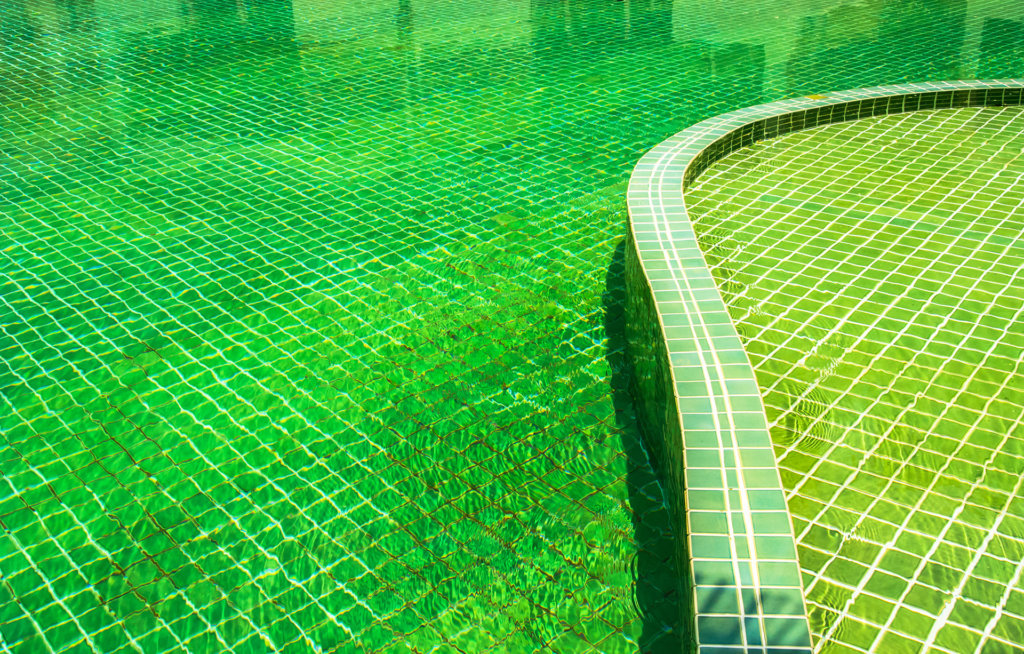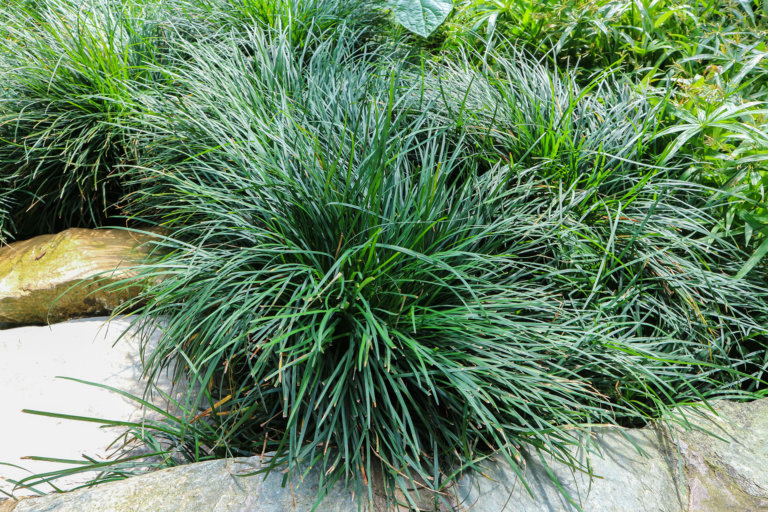Nothing ruins a plan to cool off on a hot summer day like green pool water!
Unfortunately, algae can overtake a pool in only a matter of hours, and there are many reasons it can happen.
To help you troubleshoot pool water issues and get your water crystal clear fast, just follow this step-by-step guide on how to clear green pool water.
In this guide, you’ll learn why pool water turns green, how to clean away the discoloration, and how to maintain perfect pool water. You, your family, and friends can once again enjoy a refreshing dip whenever you desire!
What Causes Green Pool Water?
The green color is caused by algae. Algae will bloom in pool water due to these common reasons:
- Low chlorine levels – algae quickly proliferates when left unchecked by chemicals that keep it under control
- Weather – algae grows best during the warm and humid swimming season, and rain quickly unbalances pool chemical levels, which allow it to swiftly take over
- Poor filtration – pool water that is not fed through the filtering system enough can be overtaken by algae
- Excessive cyanuric acid or high pH – levels that are too high in these categories hinder proper chlorination
- Infrequent cleaning – whether it’s scrubbing the sides, vacuuming the bottom, or washing the filters, all can lead to green algae growth
Green pool water is not always a matter of improper care. But, in most instances, it is.
When you do see your pool water turning green, it’s crucial to take action immediately to remedy the situation and stop it from getting worse.
Here are the steps to clear green pool water quickly, often in less than 24 hours.
Step 1: Test the Water
If you don’t test the water in your swimming pool, you won’t know the correct measures to fix the algae issue.
An unbalance of chemical levels in the pool is nearly always the culprit for green water. Still, without a quality test result, you can’t add the proper amount of material to offset the issue.
The best way to get a good test reading is to bring a sample into your local pool professional or invest in a full-spectrum at-home pool testing kit. We recommend the Taylor K2006 Complete Swimming Pool Water Test Kit, which measures more than just chlorine and pH.
It’s critical to follow the exact instructions on DIY test kits. A slight variation in technique can skew the results, making it more difficult to contain the algae bloom.
Pool water testing strips are easy to use, but the readings tend to be more of a range. This is not specific enough to treat the pool water effectively.
Step 2: Balance the pH
Before adding any chlorine or other chemicals to the pool, it’s smart first to balance the pH level. To do so, make sure your pool pump is running so the water can circulate.
If you found the pH to be too low (under 7.2), add sodium carbonate powder or granules. If the testing shows the pH is too high (8.0 or above), use sodium bisulfate in the water.
TIP: Don’t just dump the material into one area of the pool. Toss the content out over as much surface as possible, and use the skimmer to help mix it into the water.
Let the pump mix and filter the chemicals throughout the pool, then test again. A proper pH level is 7.4 to 7.8.
High pool water pH levels deactivate the chlorine and lead to algae-green water. High pH is more prevalent in saltwater pools. The chlorination process produces excess hydroxyl ions that make the pool alkaline.
Step 3: Balance the CYA and Phosphate Levels
CYA
CYA, or Cyanuric Acid, is a water conditioner that protects the chlorine from breaking down under the UV rays from the sun.
An ideal CYA level is between 30 to 50 parts per million. Too low and chlorine can disintegrate to nearly nothing in only a couple of hours, which lets algae take over.
Adding CYA is as simple as pouring a pre-mixed pool conditioner straight into the skimmer and let it circulate.
CYA over 80 ppm can “lock” chlorine, preventing it from doing its job, even if your testing shows a proper chlorine level.
Very high CYA is another issue entirely as the only suitable way to remove it from the pool is to drain some of the water and add in fresh to correct the imbalance.
Phosphate
High phosphate levels are another reason green pool water develops. Detergents from cleaning or runoff of fertilizers into the pool can raise levels above the safe 500 ppm, hindering chlorination.
Algae thrive on phosphates, so keeping it in check with a good phosphate remover will help starve algae and kill it off. Add a phosphate remover liquid per manufacturer’s instructions (typically a capful per 5,000 gallons) directly to the skimmer. It will coat the fibers and weed out the phosphates.
Step 4: Amp Up Filtration
Often, poor filtration allows pool water to stagnate enough to allow algae to multiply.
Start by checking that all filters and skimmer buckets are clear of large debris like leaves. Backwash the filter to blow out particulates that gum up the system.
Cleaning out the filters is significant when trying to eradicate algae from the pool. For severe algae problems, expect to clean out the filter several times until the water runs clear.
Another reason for poor filtration is not running the pump long enough every day. Make sure you are cycling the pool water a minimum of three times every 24 hours to ensure all the water is passing through the filters.
Step 5: Scrub the Pool
Get out your pool brush and scrub the bottom, sides, and tiles of the pool to loosen the algae and push it off the surface.
Don’t use any detergents during this step, which will only increase harmful phosphate levels and feed the algae.
Step 6: Shock the Pool
Now it’s time to super-chlorinate the pool using a shock treatment. The ideal time to apply a shock treatment is in the evening. This is because the intensity of the sun can dissolve the chlorine before it has a chance to oxidize.
The high level of chlorine will destroy bacteria and algae fast, bringing your pool water back to clarity. There are various types of liquid or granule shock treatments available. All work equally well as long as you follow the directions.
Add enough shock for the size (gallons) of your pool as per the label. Again, don’t dump the treatment in one spot; spread it out across the pool surface.
Expect the water to appear cloudy for several hours until the filters have time to clear it away. For severely green water, you may need to perform a second shock treatment.
Step 7: Vacuum
The last step to clear up green pool water is to vacuum. Dead algae and other debris will settle at the bottom of the pool and need removal.
Vacuum the sides and bottom thoroughly. While you are at it, finish up by skimming the surface to remove dead bugs and leaves.
How to Maintain Your Pool Water
Now that you have beautiful clear water again, it’s time to be vigilant about keeping it that way. Conventional pool maintenance tasks need daily attention.
Watch the Chlorine
The most important is checking chlorine levels so you can catch dips before they cause issues. For minimal pool usage, once a day should be fine. For a busy pool, checking chlorine twice a day is even better.
If you use chlorine pucks in your pool, be aware that they also add CYA. Instead, opt for a standalone chlorine product to avoid high CYA contamination.
Test the pH daily as well, to curtail green water from forming again.
Test Weekly and Verify
A weekly check of other chemical levels should suffice, but try to take a sample into a pool store as well to verify you are getting good readings at home.
Keep it Clean
Make sure you:
- Vacuum the pool often, and skim the water several times a day.
- Use a phosphate-free cleaner and a magic eraser to clean scummy build-up off pool edge tiles.
- Keep the cover on when not in use to lessen leaves and dust collecting in the water.
- Clean out the skimmer basket at least twice a week.
- Most pool filters should be backwashed every six to twelve weeks. Another indication the filter needs cleaning is when the pressure PSI builds to 7-10.
- Once or twice a year, hire a pool service to take apart and clean the filter system, depending on how many seasons you utilize the pool.
- Lastly, watch the type and amount of sunscreen or lotions on the skin that washes off into the pool water. Oily substances clog filters fast, so choose water-based versions when possible.







